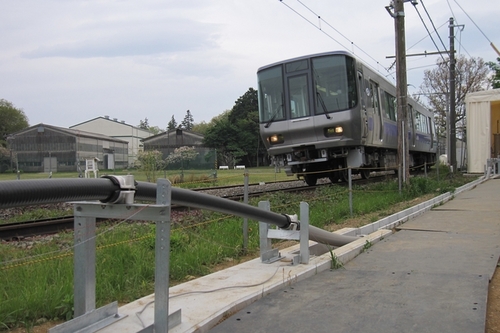November 9, 2013
Japanese Research Institute Succeeds in Test Run of Train Using Superconducting Cable
Keywords: Energy Conservation Environmental Technology University / Research institute
The Railway Technical Research Institute (RTRI) of Japan announced on July 24, 2013, that it has succeeded in a test run of a train using a superconducting cable, the first such achievement in the world.
Since the discovery of high-temperature superconductivity (the phenomenon of a material reaching a superconducting state with zero electrical resistance at the liquid nitrogen temperature of minus 196 degrees Celsius), RTRI has pursued studies on high-temperature superconducting materials as well as on the application of such materials to conventional railway systems. Applying superconducting materials to electricity grids is expected to reduce transmission loss and save energy, and is also expected to help even out the load on substations and consolidate them.
RTRI's latest superconducting cable system has a rated voltage of 1,500 and a current capacity of over 5,000 amperes, which is applicable to real railway systems. By adopting a countercurrent circulation system to circulate the cooling medium (supercooled liquid nitrogen), the institute was able to integrate the cooling mechanisms and reduce its size. RTRI installed this system (31 meters) in a railway at its laboratory and successfully propelled a train using the system.
RTRI will continue to conduct experiments with a view to optimizing the cable structure. Moreover, it also intends to conduct tests using longer cables of the same type, in order to complete a system suitable for use in real railway systems.
Related JFS Articles
Related
"JFS Newsletter"
Related
"Popular Articles"
- New Nano-Bubble Technology May Help Dissolve Sludge and Improve Water Quality
- Japanese Firm Begins Development of Tidal Power Generation System
- Small Hydropower Generation System Developed for Use in Seawater, Weight Cut by Half
- Constructed Wetland Facility Established by Japanese University Purifies Livestock Farming Drainage
- Toyota CRDL Succeeds in World's First Artificial Photosynthesis Using only Water and CO2



